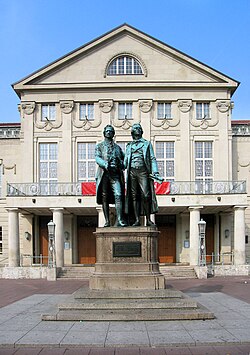Weimar | |
|---|---|
View over Weimar with Schloss Weimar and the Goethe-Schiller Monument in front of the Deutsches Nationaltheater and Staatskapelle Weimar | |
| Coordinates: 50°58′52″N 11°19′46″E / 50.98111°N 11.32944°E | |
| Country | Germany |
| State | Thuringia |
| District | Urban district |
| Subdivisions | 12 districts |
| Government | |
| • berbürgermeister (2024–30) | Peter Kleine[1] |
| Area | |
• Total | 84.48 km2 (32.62 sq mi) |
| Elevation | 208 m (682 ft) |
| Population (2022-12-31)[2] | |
• Total | 65,620 |
| • Density | 780/km2 (2,000/sq mi) |
| Time zone | UTC+01:00 (CET) |
| • Summer (DST) | UTC+02:00 (CEST) |
| Postal codes | 99423, 99425, 99427, 99428 |
| Dialling codes | 03643, 036453 |
| Vehicle registration | WE |
| Website | weimar.de |
Weimar[a] is a city in the German state of Thuringia, in Central Germany between Erfurt to the west and Jena to the east, 80 km (50 mi) southwest of Leipzig, 170 km (106 mi) north of Nuremberg and 170 km (106 mi) west of Dresden. Together with the neighbouring cities of Erfurt and Jena, it forms the central metropolitan area of Thuringia, with approximately 500,000 inhabitants. The city itself has a population of 65,000. Weimar is well known because of its cultural heritage and importance in German history.
The city was a focal point of the German Enlightenment and home of the leading literary figures of Weimar Classicism, Johann Wolfgang von Goethe and Friedrich Schiller. In the 19th century, composers such as Franz Liszt made Weimar a music centre. Later, artists and architects such as Henry van de Velde, Wassily Kandinsky, Paul Klee, Lyonel Feininger, and Walter Gropius came to the city and founded the Bauhaus movement, the most important German design school of the interwar period.
The political history of 20th-century Weimar was volatile: it was the place where Germany's first democratic constitution was signed after the First World War, giving its name to the Weimar Republic (1918–33). It was also one of the cities mythologized by Nazi propaganda.
Until 1948, Weimar was the capital of Thuringia. Many places in the city centre have been designated as UNESCO World Heritage Sites, either as part of the Classical Weimar complex (containing monuments to the classical period of Weimar in 18th and 19th centuries) or the Bauhaus complex (containing buildings associated with the Bauhaus art school).[3][4] Heritage tourism is one of the leading economic sectors of Weimar.
Noted institutions in Weimar are the Bauhaus University, the Liszt School of Music, the Duchess Anna Amalia Library, and two leading courts of Thuringia (the Supreme Administrative Court and Constitutional Court). In 1999, Weimar was the European Capital of Culture.
- ^ Gewählte Bürgermeister - aktuelle Landesübersicht, Freistaat Thüringen. Retrieved 25 June 2024.
- ^ "Bevölkerung der Gemeinden, erfüllenden Gemeinden und Verwaltungsgemeinschaften in Thüringen Gebietsstand: 31.12.2022" (in German). Thüringer Landesamt für Statistik. June 2023.
- ^ "Classical Weimar". UNESCO World Heritage Centre. United Nations Educational, Scientific, and Cultural Organization. Archived from the original on 29 July 2022. Retrieved 29 July 2022.
- ^ "Bauhaus and its Sites in Weimar, Dessau and Bernau". UNESCO World Heritage Centre. United Nations Educational, Scientific, and Cultural Organization. Archived from the original on 26 February 2021. Retrieved 29 December 2018.
Cite error: There are <ref group=lower-alpha> tags or {{efn}} templates on this page, but the references will not show without a {{reflist|group=lower-alpha}} template or {{notelist}} template (see the help page).






